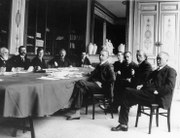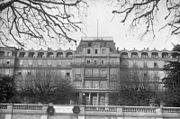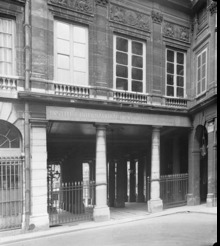| International Committee on Intellectual Cooperation | |||||||
|---|---|---|---|---|---|---|---|
| 1922–1946 | |||||||
| Status | International organisation | ||||||
| Capital | Geneva | ||||||
| Historical era | Interwar period | ||||||
| • Creation | 1922 | ||||||
| • Dissolution | 1946 | ||||||
| |||||||

The International Committee on Intellectual Cooperation, sometimes League of Nations Committee on Intellectual Cooperation, was an advisory organisation for the League of Nations which aimed to promote international exchange between scientists, researchers, teachers, artists and intellectuals. Established in 1922, it counted such figures as Henri Bergson, Albert Einstein, Sarvepalli Radhakrishnan, Jagadish Chandra Bose, Nitobe Inazo, Marie Curie, Gonzague de Reynold, Leonardo Torres Quevedo, and Robert A. Millikan among its members. The committee was the predecessor to UNESCO, and all of its properties were transferred to that organisation in 1946.
The International Committee on Intellectual Cooperation (Geneva)
The International Committee on Intellectual Cooperation (ICIC) was formally established in August 1922. Having started out with 12 members, its membership later grew to 19 individuals, mostly from Western Europe. The first session was held on August 1, 1922, under the chairmanship of Henri Bergson. During its lifetime, the committee attracted a variety of prominent members, for instance Albert Einstein, Marie Curie, Kristine Bonnevie, Jules Destrée, Robert Andrews Millikan, Alfredo Rocco, Paul Painlevé, Leonardo Torres Quevedo, Gonzague de Reynold, Jagadish Chandra Bose and Sarvepalli Radhakrishnan. Einstein resigned in 1923, protesting publicly the committee's inefficacy; he rejoined in 1924 to mitigate the use German chauvinists made of his resignation. The body was successively chaired by:
- Henri Bergson (1922–1925)
- Hendrik Lorentz (1925–1928)
- Gilbert Murray (1928–1939).
The ICIC maintained a number of sub-committees (e.g. Museums, Arts and Letters, Intellectual Rights or Bibliography) which also worked with figures such as Béla Bartók, Thomas Mann, Salvador de Madariaga and Paul Valéry.
The ICIC worked closely with the International Educational Cinematographic Institute created in Rome in 1928 by the Italian government under Mussolini.
The last session took place in 1939, but the ICIC was only formally dissolved in 1946, like the League of Nations.
-
 ICIC Plenary session (date unknown, between 1924 and 1927).
ICIC Plenary session (date unknown, between 1924 and 1927).
-
 Henri Bergson (ICIC president) to Inazo Nitobe (International Bureaux Section director), 1924.
Henri Bergson (ICIC president) to Inazo Nitobe (International Bureaux Section director), 1924.
-
 ICIC Plenary session 1939.
ICIC Plenary session 1939.
-
 The Palais Wilson (Geneva), seat of the LoN and the ICIC between 1922 and 1937.
The Palais Wilson (Geneva), seat of the LoN and the ICIC between 1922 and 1937.
The International Institute of Intellectual Cooperation (Paris)

To support the work of the commission in Geneva, the organization was offered assistance from France to establish an executive branch, the International Institute of Intellectual Cooperation (IIIC), in Paris in 1926. However, the IIIC had an autonomous status and was almost only financed by the French government, giving it a certain independence that created tensions with the League of Nations. It maintained relations with the league's member states, which established national commissions for intellectual cooperation and appointed delegates to represent their interests at the institute in Paris. While being an international organisation, each of the IIIC's three successive directors was French:
- Julien Luchaire (1926–1930)
- Henri Bonnet (1931–1940)
- Jean-Jacques Mayoux (1945–1946)
From 1926 to 1930, Alfred Zimmern – the well-known British classicist and a pioneering figure in the discipline of international relations – served as the IIIC's deputy director.
As a result of the Second World War, the institute was closed from 1940 to 1944. It re-opened briefly from 1945 to 1946. When it closed for good in 1946, UNESCO inherited its archives and some parts of its mission.
References
General
- Northedge, Frederick (1953). International Intellectual Co-operation Within the League of Nations: Its Conceptual Basis and Lessons for the Present. London: University of London.
- Renoliet, Jean-Jacques (1999). L'UNESCO oubliée, la Société des Nations et la coopération intellectuelle (1919-1946) [The Forgotten UNESCO, the League of Nations and Intellectual Cooperation (1919-1946)] (in French). Paris: Publications de la Sorbonne. ISBN 978-2-85944-384-9.
- Grandjean, Martin (2018). Les réseaux de la coopération intellectuelle. La Société des Nations comme actrice des échanges scientifiques et culturels dans l'entre-deux-guerres [The Networks of Intellectual Cooperation. The League of Nations as an Actor of the Scientific and Cultural Exchanges in the Inter-War Period]. Lausanne: Université de Lausanne. (English summary)
- Centenary of the International Committee on Intellectual Cooperation of the League of Nations. Geneva: United Nations Library and Archives. 2022.
Specific
- Laqua, Daniel (2011). "Transnational Intellectual Cooperation, the League of Nations, and the Problem of Order" (PDF). Journal of Global History. 6 (2): 223–247. doi:10.1017/s1740022811000246. S2CID 144836940.
- Pernet, Corinne (2014). "Twists, Turns, and Dead Alleys: The League of Nations and Intellectual Cooperation in Times of War". Journal of Modern European History. 12 (3): 342–358. doi:10.17104/1611-8944_2014_3_342. S2CID 147056397.
- Grandjean, Martin (2017). "Complex structures and international organizations" [Analisi e visualizzazioni delle reti in storia. L'esempio della cooperazione intellettuale della Società delle Nazioni]. Memoria e Ricerca (2): 371–393. doi:10.14647/87204. See also: French version (PDF) and English summary.
- Shine, Cormac (2018). "Papal Diplomacy by Proxy? Catholic Internationalism at the League of Nations". The Journal of Ecclesiastical History. 69 (4): 785–805. doi:10.1017/S0022046917002731.
- Grandjean, Martin (2020). "A Representative Organization? Ibero-American Networks in the Committee on Intellectual Cooperation of the League of Nations (1922–1939)". Cultural Organizations, Networks and Mediators in Contemporary Ibero-America: 65–89. doi:10.4324/9780429299407-6. S2CID 240784377.
- Grandjean, Martin (2022). "The Paris/Geneva Divide. A Network Analysis of the Archives of the International Committee on Intellectual Cooperation of the League of Nations". Culture as Soft Power: Bridging Cultural Relations, Intellectual Cooperation, and Cultural Diplomacy: 65–98. doi:10.1515/9783110744552-004.
Notes
- League of Nations archives, United Nations Office in Geneva. With a network Visualization of the ICIC archives, showing thousands of documents exchanged between the plenary committee, its secretary, national commissions and experts. Grandjean, Martin (2014). "La connaissance est un réseau" (PDF). Les Cahiers du Numérique. 10 (3): 37–54. doi:10.3166/lcn.10.3.37-54. (PDF), Grandjean, Martin (2015). "Introduction à la visualisation de données : l'analyse de réseau en histoire". Geschichte und Informatik. 18/19: 109–128.
- Laqua 2011.
- ^ Grandjean 2022.
- Shine 2018.
- Pernet 2014.
- Grandjean 2018.
- ^ Grandjean 2020.
- Grandjean 2017.
- Albert Einstein, Ideas and Opinions (New York: Bonanza/Crown, 1954), p. 84.
- "International Educational Cinematographic Institute" (PDF). biblio. 17 December 1929. Retrieved 23 September 2021.
- LoN archives 1924, United Nations Offices in Geneva. Picture from this collection.
- Rodríguez-Casañ, Rubén; Carbó-Catalan, Elisabet; Solé-Ribalta, Albert; Roig-Sanz, Diana; Borge-Holthoefer, Javier; Cardillo, Alessio (24 October 2024). "Analysing inter-state communication dynamics and roles in the networks of the International Institute of Intellectual Cooperation". Humanities and Social Sciences Communications. 11 (1): 1–9. doi:10.1057/s41599-024-03829-1. ISSN 2662-9992.
- "UNESCO Archives". Archived from the original on 19 August 2021. Retrieved 20 June 2016.
- Renoliet 1999.
External links
- Research Guide on Intellectual Cooperation by UN Archives Geneva.
- Intellectual Cooperation and International Bureaux Section at UN Archives Geneva.